- Theory of engineering optical fields on the nanoscale
- Nano- and microfabrication
- Performance, reliability and upscaling of novel organic solar cells and light-emitting devices
- Hybrid plasmonic systems for optoelectronics
- Functional organic and inorganic thin films
- Improved sensor materials for harsh environments
Theory of optical properties of nanowire metamaterial with gain
In this work, we demonstrate a non-monotonic dependence of nanowire metamaterial optical coefficients on the surrounding media’s gain. The effect is based on the field redistribution between the lossy nanowires and the amplifying host matrix and it significantly depends on the metamaterial lattice constant.
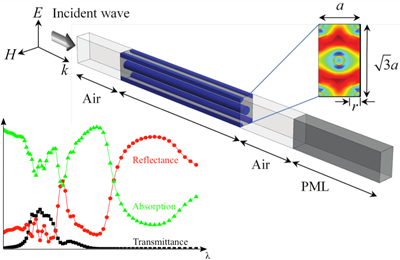
More information
Associate Professors Vladimir Bordo and Jost Adam
Publication
J. Lima, J. Adam, D. Rego, V. Esquerre, V. Bordo, “Optical properties of nanowire metamaterials with gain,” Opt. Commun. 379 (2016) 25-31.
Fabrication of porous Al2O3 templates
In this work, nanostructures are fabricated via anodic oxidation of Aluminum thin films. The resulting corrugated electrodes are integrated in organic solar cells to improve the efficiency of the cells.
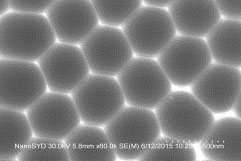
More information
Dr. Arkadiusz Gosczak
Publications
„On-substrate fabrication of porous Al2O3-templates with tunable pore diameters and interpore-distances“, Nele Berger, Salah Habouti, Horst-Günter Rubahn and Mohammed Es-Souni, Applied Physics A 122(2016)192.
A. J. Goszczak, J. Adam, P. P. Cielecki, J. Fiutowski, H.-G. Rubahn and M. Madsen. “Nanoscale Aluminum concaves for light-trapping in organic thin-films” Opt. Commun., 370, 135 (2016)
Stabilization of organic solar cells
In this work additives such as UV absorbers are implemented into organic solar cells to improve their overall lifetime (FTP-project Stabil-O). In a new project starting 2017 (CompliantPV), this is extended to improve also mechanical stability in flexible devices.
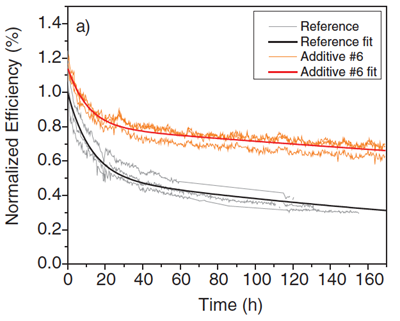
More information
Associate Professor Morten Madsen
Publication
V. Turkovic, S. Engmann, N. Tsierkezos, H. Hoppe, M. Madsen, H.-G. Rubahn, U. Ritter and G. Gobsch. ”Long-Term Stabilization of Organic Solar Cells using UV Absorbers” J. Phys. D: Appl. Phys, 49, 125604 (2016)
Coupling of plasmonic surfaces with organic nanostructures
In this work we show that the optical response of organic materials can be controlled by forming organic-plasmonic hybrid systems. The interaction between organic nanoaggregates and engineered optical near fields may lead to strongly enhanced optical response. Furthermore, the strong plasmonic-exciton interaction might be interesting for plasmonic applications, where organic nanofibers could be exploited as active components, responsible for plasmon generation or modulation.
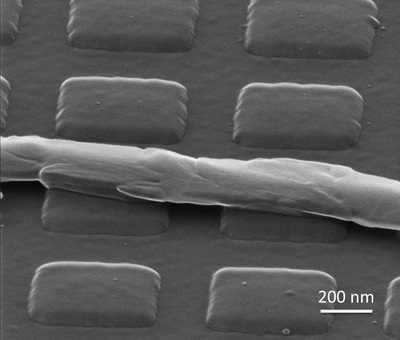
More information
Associate Professor Jacek Fiutowski
Publications
Goszczak, AJ, Adam, J, Cielecki, PP, Fiutowski, J, Rubahn, H-G & Madsen, M 2016, 'Nanoscale aluminum concaves for light-trapping in organic thin-films' Optics Communications, vol 370, pp. 135-139
Elżbieta K. Sobolewska ; Till Leißner ; Leszek Jozefowski ; Jonathan Brewer ; Horst-Günter Rubahn ; Jost Adam ; Jacek Fiutowski; Surface plasmons excited by the photoluminescence of organic nanofibers in hybrid plasmonic systems. Proc. SPIE 9884, Nanophotonics VI, 98843D (April 21, 2016)
Chiral assemblies from achiral organic building blocks
Deposition of MOP4 on mica leads to two types of nanofibers, “L” and “R”. Their images in a mirror “M” cannot brought in coincidence with themselves, similar to a left and a right hand. This “chirality” is induced by the substrate.
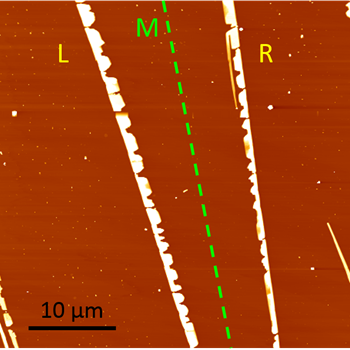
More information
Associate Professor Frank Balzer
Publication
“Thin film phase and local chirality of surface-bound MOP4 nanofibers” Frank Balzer,Christian Röthel, Horst-Günter Rubahn, Arne Lützen,Jürgen Parisi, Roland Resel, and Manuela Schiek, J.Phys.Chem.C 120(2016)7653.
Read more at this webpage
Improved sensor materials for harsh environments
In collaboration with Danfoss Industrial Automation, NanoSYD researchers have developed new sensor materials that can operate at elevated temperatures. This has led both to an improved basic understanding of the material systems and opportunities for product improvement.
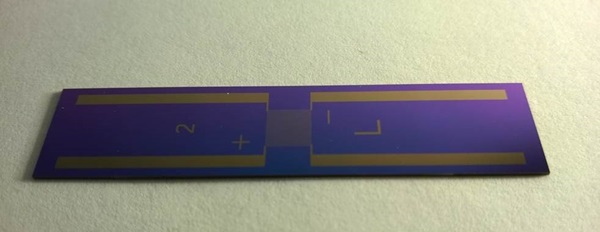
More information
Associate Professor Jakob Kjelstrup-Hansen
Publication
Nis Dam Madsen et al. ”Titanium Nitride as a Strain Gauge Material”,
IEEE Journal of Microelectromechanical Systems, in press, published on-line, DOI: 10.1109/JMEMS.2016.2577888